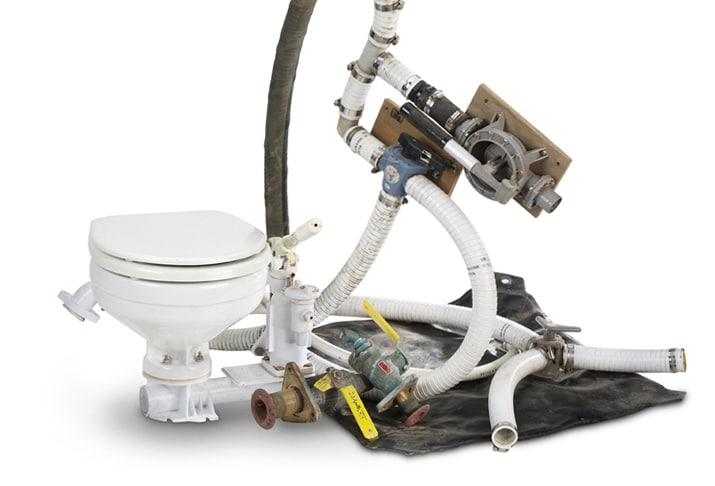
Just about every sailor has a head story, which is usually humorous and quite likely fairly gross. These stories typically include massive clogs, holding-tank issues, or pump malfunctions that occur at just the wrong time (really, is there a right time?), followed by a debate over marine and environmental issues and the merits of replacing the whole marine toilet system with just a bucket. And while a bucket may eliminate plumbing and holding tanks, the experience of using and dumping said tub leaves something to be desired. Fortunately, sailors today have more boat toilet choices than in the past, and those choices are more reliable and cost efficient than ever.
Unlike household toilets, which are all pretty much the same, marine toilets come in different shapes and sizes and have different flush mechanisms and tank options, so you can design a system that works for your boat, budget, and cruising plans. While the emphasis here will be on what’s available in marine heads, this is also the time to take a look at what the experts refer to as the marine-sanitation-device system. New, high-quality, sanitation-grade hoses, a clear vent hose, and a new or scrubbed-out holding tank will go a long way to ensuring that the system operates as efficiently and as free of odor as possible. If replacing your head and related sanitation gear is in your future, you may want to consider an upgrade to an electric head, a vacuum head, or even a composting head. Or if you’re on a tight budget, you can always go back to basics, so to speak.
Manual Boat Toilets ($200 to $1,750)
Keeping it simple certainly has its merits, and manual boat toilets have done the job for years. From the venerable (but now hard to find) Wilcox-Crittenden Skipper head to the widely available Jabsco manual head ($200), cruising sailors have relied on these due to ease of use, simple system designs, readily available rebuild kits, and, in the case of the Jabsco, low replacement cost. If you’re going to replace your head with another manual boat toilet, consider looking for one that’s pumped with a back-and-forth motion, such as the Groco K-H manual head ($1,750), because many people find this easier than an up-and-down motion. A bronze base is more robust than a plastic one and may hold up longer, too, and a large joker valve clogs less frequently.
Electric Marine Toilets ($550 to more than $1,600)
A common marine toilet upgrade is to go electric, which can sometimes be as simple as installing an electric pump in an already compatible system. An electric marine toilet eliminates the need to manually pump, pump, pump to clear the bowl. Electric heads also typically include a macerator as well, which is similar to a garbage disposal and grinds up waste and paper before discharge into the holding tank (or overboard, if you’re offshore). All you do is push a button. This simplicity is nice if you frequently have landlubbers aboard. “They’re easy to use for those who come on board and aren’t familiar with a marine system, and they do a good job of chopping up any solids before it enters the sanitation hose, reducing the possibility of a clog,” says John Corbishley of Ocean Link (oceanlinkinc.com), a marine-systems specialist with an office in Portsmouth, Rhode Island.
Some electric marine toilets, such as the Jabsco Lite-Flush ($659), are designed as a direct replacement for a specific manual head, which typically makes for easier installation. “When choosing a macerating electric head, another element that we consider is access to the moving parts,” Corbishley continues. “If they’re located in more than one area, like a locker or under a platform, they’re much harder to service. The macerator blades are one of the major components to fail when the wrong thing is introduced to the toilet, so they need to stand up to the job.”
Electricity consumption, which is almost always a concern on cruising boats, is something to think about when switching to an electric marine toilet. Corbishley says that the draw on the electrical system is minimal on a typical modern cruising boat. However, he notes that when the head is used, there is a brief load burst of between 20 and 30 amps, so each head should have its own breaker, either at the boat’s panel or a separate breaker somewhere else.
An electric macerating toilet that Corbishley recommends to his customers who are looking to upgrade the head on their sailboats is Saniflo’s SaniMarin (from $670). He notes that the parts are all located under the china bowl and that by undoing three screws, you can pivot the unit and gain access to those inner workings. The macerator blade is stainless steel, and the pump is quite powerful, which reduces clogs.
If nothing’s too good for your boat and you’re truly looking for a throne, Tecma’s X-Light carbon-fiber head may suit your fancy. It’s the most expensive head that we could find (not to mention the coolest-looking one!), at prices that start at just over $10,000.
Vacuum Marine Toilets ($400 to $2,000)
Vacuum systems have been used on larger poweryachts for many years. They work well; however, since the systems are usually large and use fresh water to flush, many sailors have stayed away from them. A new product from Dometic may change that.
The SailVac holding-tank system, when paired with one of its VacuFlush marine toilets ($1,670 for both), is specifically designed for the small spaces typically found on most sailboats (editor’s note July 2020: Dometic does not seem to be producing the SailVac any longer). The SailVac combines a vacuum pump, vacuum reservoir, and holding tank into one unit. A real benefit of vacuum systems is that although they use fresh water to flush, they use only a very modest amount, usually around a pint or so. They also typically use much less power (three amps at 12 volts DC for the SailVac) than a standard macerating electric head.
Popular among sailors for its reliability, the Lavac head (from $440) also uses vacuum pressure to clear the bowl, but it works differently than the SailVac system. When you close the lid on the Lavac, a seal forms. A diaphragm pump, the only moving part, then creates a vacuum, which pulls out the waste and draws in the flush water. After a few seconds, the vacuum breaks, and the toilet is ready to be used again.
After using a Lavac head on some other boats, cruising sailor Brian Cole decided to install one on his own vessel. After using it for a couple of years, he offers a few thoughts. On the plus side, since the pump is external and has simple gaskets, the Lavac is easy to fix and rarely clogs.
However, Cole finds that the Lavac uses more water for a full flush than does a manual head, and the normal installation requires a user to wait about 30 seconds before being able to open the lid, which can be a problem if there’s an ill person on board. “Other than that,” Cole says, “I’d recommend the Lavac over any head that we’ve ever had or used on board. The simplicity is wonderful. The installation does require a little more thought, but the long-term repair benefits are worth it.”
Composting Toilets ($800 to $1,000)
A relative newcomer to the marine-toilet marketplace, composting heads are starting to make their way onto more boats. Such composting heads as the Air Head ($1,030) or Nature’s Head ($925) offer a major benefit over other systems in that they require no through-hulls. Both toilets work in the same way: Moist, crumbled peat moss is put in the composting chamber at the bottom portion of the toilet. When the toilet is used, liquid waste is channeled into a separate tank, while solid waste goes into the composting chamber. You turn a crank handle, which agitates the contents; the process to transform it all into compost begins immediately. An integral 12-volt vent fan keeps the compost dry and hastens the process. According to Air Head, the solid tank has enough capacity for a couple to use it during a month of living aboard before needing to empty it; however, the liquid tank needs to be emptied every two or three days.
Although sailors switching over to a composting head will definitely have to deal with a learning curve—not to mention the job of removing all parts of the previous system—the composting head, when set up and maintained properly, should be free of odor, and you’ll never have to worry about clogged hoses or finding pumpout stations again.The marine head has certainly come a long way from its beginnings as a hole in the bow of a ship, and while you’ll still probably need to give thorough instructions on head procedures to all your onboard guests, with the many advances in toilets and M.S.D. systems, those gross, though amusing, head stories may become a thing of the past.Installing a new marine toilet is within the skill set of most do-it-yourselfers, but if you’re completely redesigning your system or, say, upgrading from a manual head to a vacuum system, you may want to consult with someone who has experience with marine plumbing.
Jen Brett, CW senior editor, is a liveaboard sailor who’s somehow managed to convince her husband to do all of the head rebuilds—so far.








